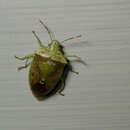en
names in breadcrumbs


In Banasa calva, the diploid number of chromosomes is 26 in both sexes.
Often confused with Banasa dimiata.
Length is between 9 an 11mm.
Typically appears greenish-yellow, sometimes with small tinges of red coloring on the coria. However, it may also appear brown or orange-brown, depending on the time of year and locality.
The head may be green or brown, and is slightly curvy in front of the eyes (sinuate).
The antennal segments may alternate between green and reddish-brown coloration.
The second antennal segment is approx. 3/4 as long as the third antennal segment.
The abdomen is paler in color than the head and thorax, and has conspicuous dark spots along the margins.
The pronotum is two-toned (see pictures).
First gonocoxae with posterior margin sinuate, mesial angles weakly lobate.
Pygophore with inferior ridge broadly V-shaped, lateral angles darkened and crenulate.
Proctiger with feeble, median longitudinal carina.
Help create a portrait of California stinkbug diversity and distribution by submitting your observations.A field guide to some of the stink bug taxa found in Southern California is now available athttp://www.inaturalist.org/guides/887. Smartphone users can use iNaturalist apps, or use the Riverside NatureSpotter app (available free online for iPhone and Android devices); or upload data and image files directly to the project site. Hosted by the City of Riverside, California's Metropolitan Museum, verification of observations will be carried out by Museum staff, University of California-Riverside Entomology personnel, plus other entomologists and iNaturalist users.
Most stink bugs are large, easy to photograph, and their egg masses are conspicuous. As observations accumulate, iNaturalist creates a checklist of observed species for the project. These observations may also provide early detection of the spread of introduced pest species, such as the Brown Marmorated Stinkbug (Halyomorpha halys).
http://www.inaturalist.org/projects/seeking-all-southern-california-stinkbugs
Banasa calva is a species of stink bug in the family Pentatomidae. It is found in Central America and North America.[1][2][3]
Banasa calva is a species of stink bug in the family Pentatomidae. It is found in Central America and North America.
